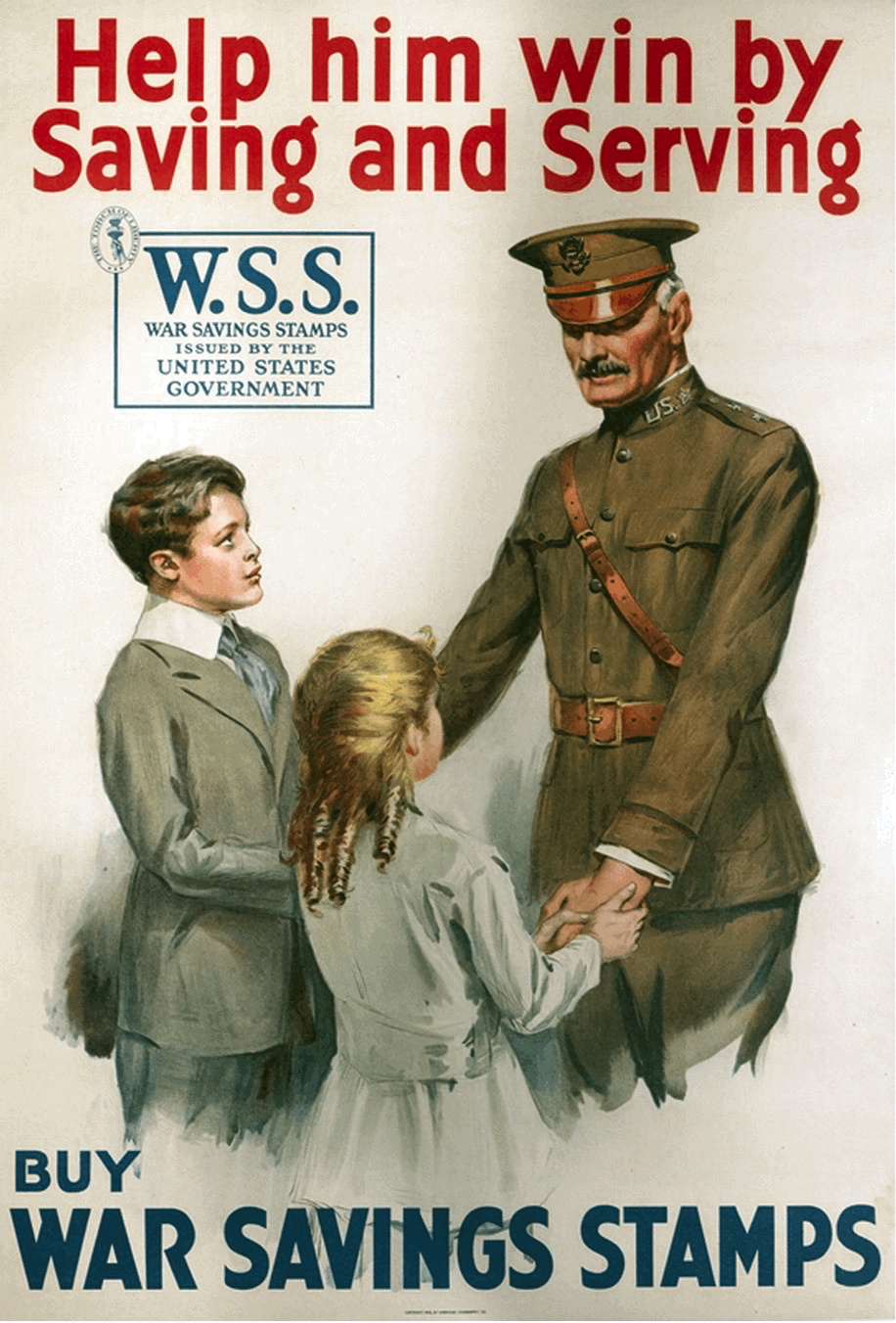From January 1, 1911 through July 1, 1967, the United States Postal System operated a Postal Savings System. During this 56-year period, depositors could keep deposits within the system, earning a two percent annual interest rate on their savings. In 1947, at the height of the program, some $3.4 billion was held in postal deposits. For those who were wary of banks, for new immigrants, this system provided a secured means by which to save money, as all deposits were guaranteed by the full faith and credit of the U.S. Government. Many countries had postal savings systems as an alternative to traditional banks. Immigrants would be familiar with postal savings from their own native countries.
When the program began, certificates of deposits were issued, in denominations of $1, $2, $5, $10, $20, and $100. Depositors could save smaller amounts with ten-cent postal savings stamps affixed to postal savings cards. From 1911-1935, Postal Savings Bonds were available to depositors, paying a slighter higher rate (2.5% ) than the certificate of deposits. With the introduction of the U.S. Savings Bond Program, Postal Savings Bonds were discontinued in 1935.
After the Second World War, the American economy flourished. Banks could match the safety of postal savings, and U.S. Savings Bonds remained an attractive form of safekeeping money for the future. The Postal Savings System had peeked, and by 1966, the Post Office began to wind down the program. By 1971, monies unclaimed were sent to the states, and by 1985, the outstanding postal certificates of deposit were no longer honored. The Savings Stamps and Postal Savings Bonds are still valid obligations of the government. The Herbstman Collection features examples of savings stamps, certificates of deposit, and Postal Savings Bonds.
The U.S. Treasury also utilized a stamp program for savings. The War Savings Stamp issues of the First World War were early forms of zero-coupon securities, meaning that the interest earned by ownership would only be realized upon redemption of War Savings Certificates. The Defense and (later) War Savings Stamps of WWII were different: their sole purpose was to serve as a savings mechanism for the purchase of U.S. Defense Bonds. The stamps themselves earned no interest. Presented here are the War Savings Stamp issues of 1918 -1921, the rare interwar Treasury Savings Issue of 1921, and the Savings Stamp issues of WWII.


1911 Postal Savings Cards and Stamps
These cards, when affixed with nine additional postal savings stamps, would be accepted as a $1 deposit into a postal savings account. An orange and a blue variant were issued by the Postal Service. The savings card and savings stamps were issued in a 10 cent denomination. When the card contained a dollar of stamps, the Post Office would credit the depositor in a new or existing postal savings account.
_edited.jpg)
_edite.jpg)
.jpg)
1912 $500 Twenty-year Postal Savings Bond
Two and One-half Percent Registered Specimen
Until the beginning of the U.S. Savings Bond Program, Postal Savings Bonds provided an alternative savings option to traditional Treasury securities. Paying interest in January and July, this security was exempt from any federal, state, and/or local taxation.
This specimen is possibly unique.

1950 $500 Postal Certificate of Deposit
Two Percent Certificate

1941 Savings Bonds / Postal-Savings Certificate Receipt
This postal form was used as a receipt for customers who purchased either U.S. Savings Bonds or Postal-Savings Certificates



Postal Savings System Account Documents
Each Postal Savings Depositor was given a unique account number on a wallet/purse card. In addition, a deposit card (to record transactions) along with a deposit envelope were provided.
1918 - 1921 $5 War Savings Stamps
As part of the funding effort of World War I, the Treasury issued War Savings Stamps to raise revenue. Each stamp was issued at a discount and had a duration of five years, giving the stamps the properties of a zero-coupon security. Since the smallest denomination war bond was $50, these stamps were seen as an affordable way to contribute to the war effort. Each five-dollar series had a corresponding booklet to affix the stamps within. In addition, the Treasury Department issued a 25-cent Thrift Stamp. A completed book of these stamps could then be exchanged for a War Savings Stamp. The program raised some $900 million for the Treasury.
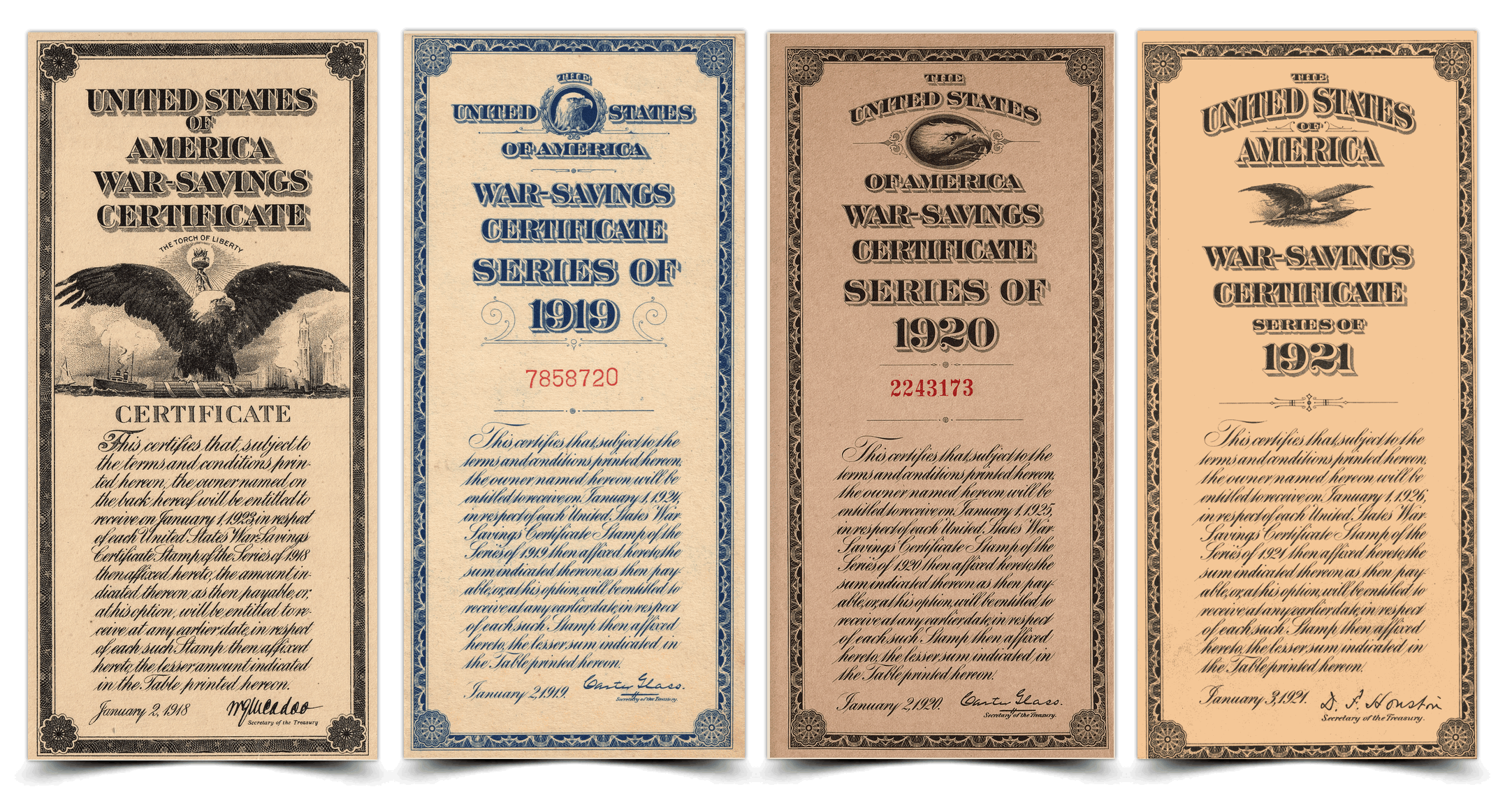
Series 1918
Series 1919
Series 1920
Series 1921




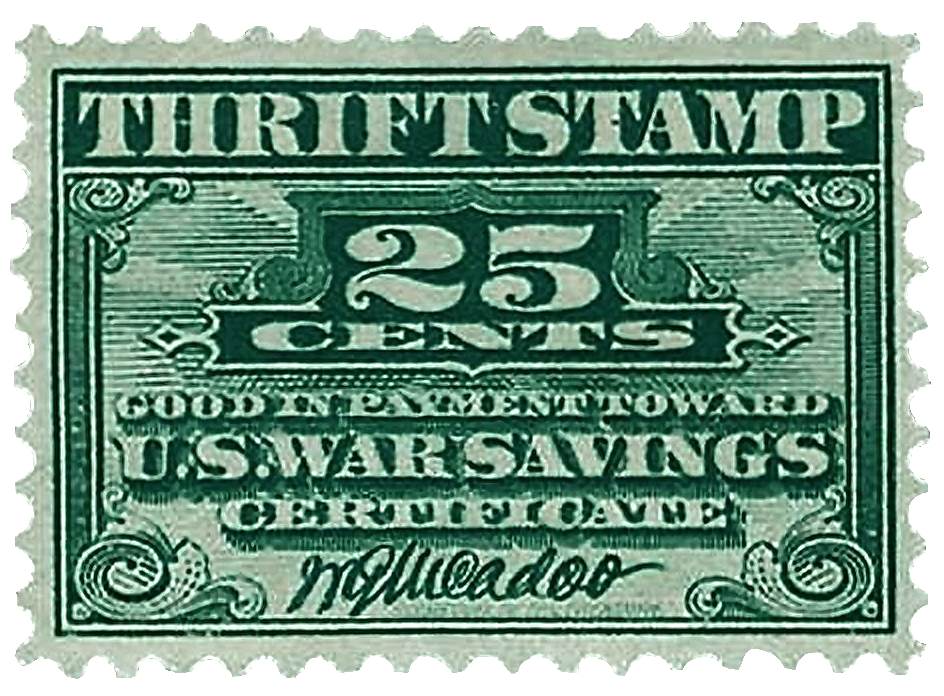
1918 25¢ War Savings Thrift Stamp
As an alternative to the War Savings Stamps, this thrift stamp was issued as a means of saving for the $5 stamp over time. Unlike the $5 stamps, the thrift stamps paid no interest. It was saved on cards of sixteen stamps which, when combined with a small payment (depending on the month), would then be exchanged by the Treasury Department for a $5 stamp.
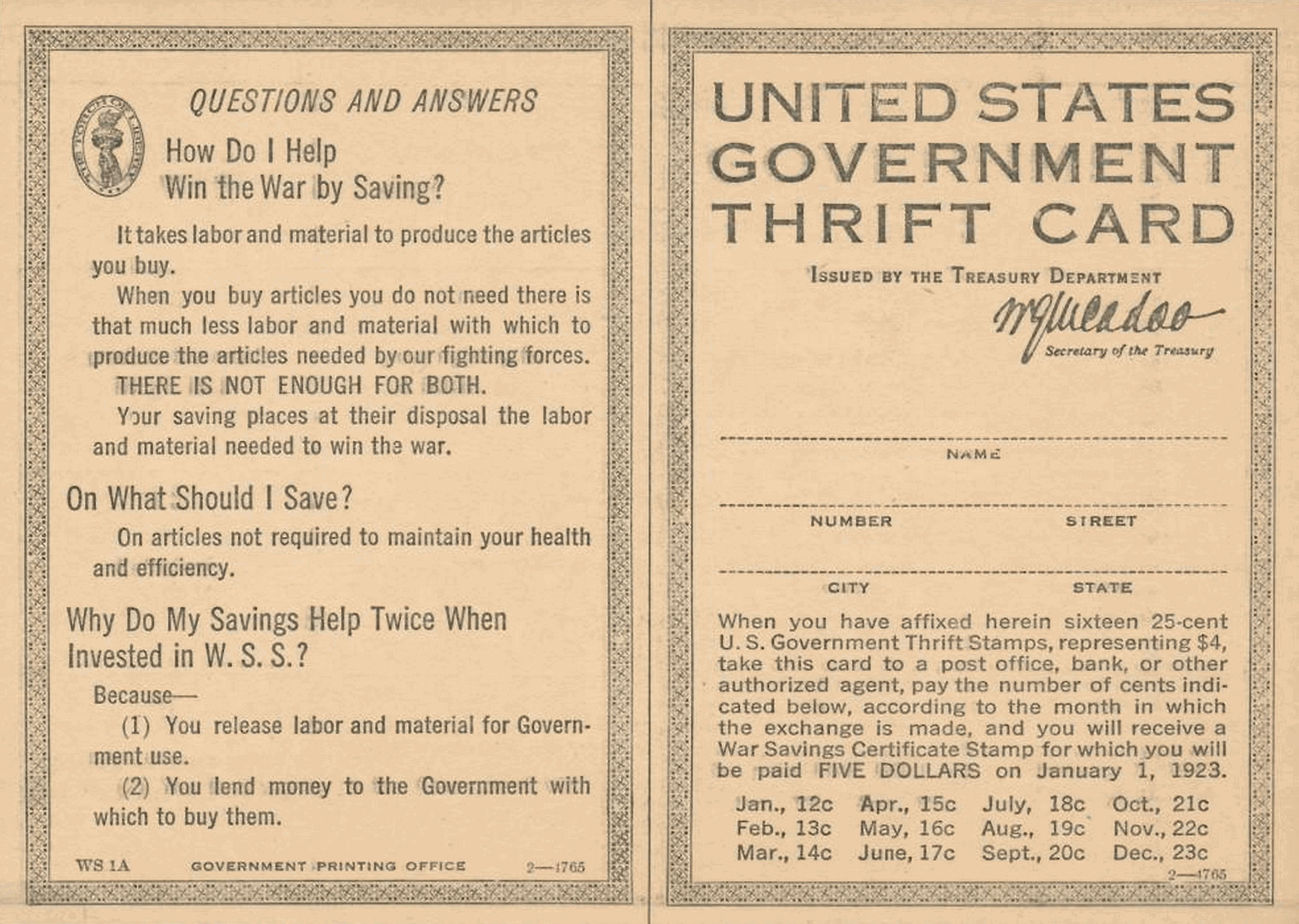
25¢ Thrift Stamp Small Savings Card


War Savings Certificate Envelope

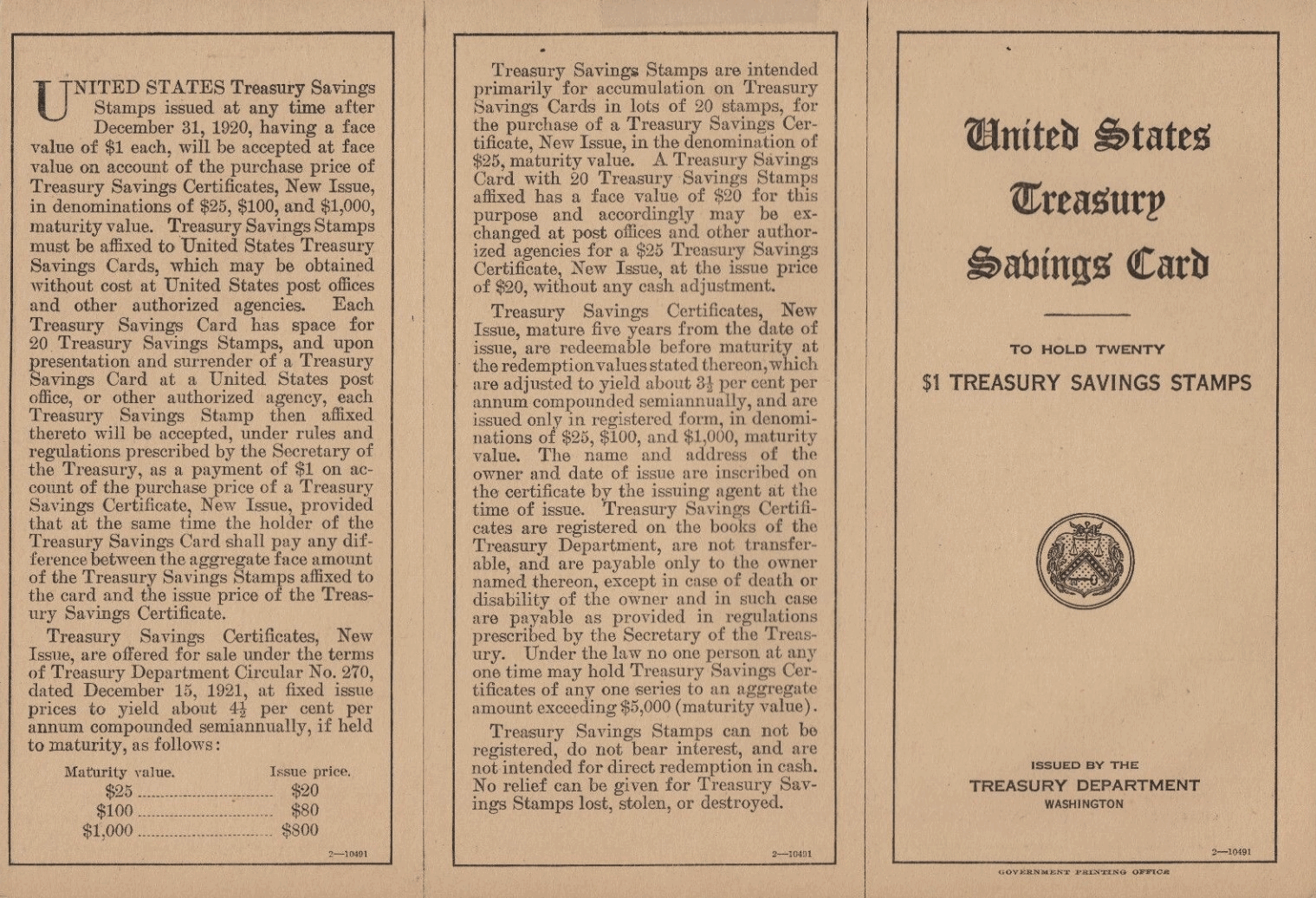
1921 Treasury Savings Card
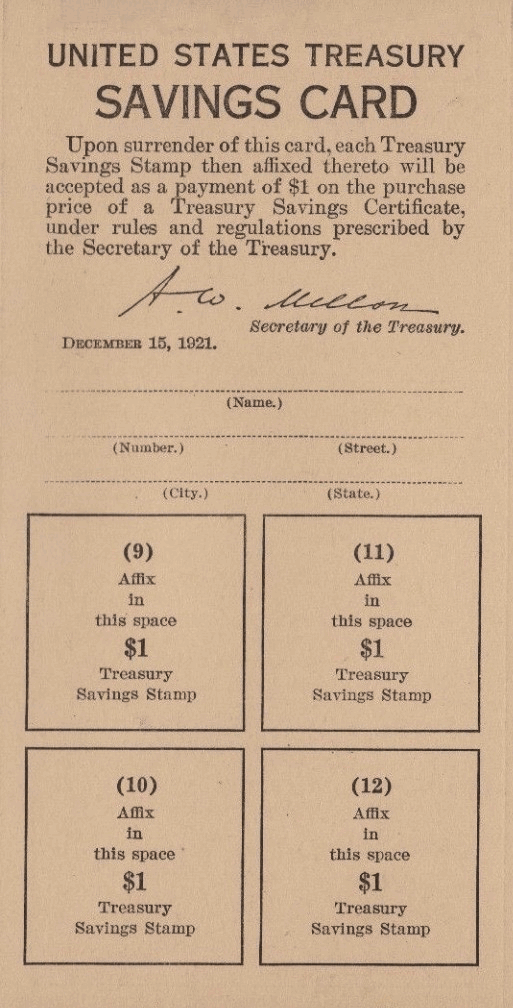

1921 $1 Treasury Savings Stamp
This $1 savings stamp was issued by the Treasury in the post-war period. Sold individually, it would be affixed to a savings card holding twenty stamps. The card would subsequently be exchanged for a Treasury Savings Certificate, which would yield approximately 4½% per annum, compounded semiannually, if held to maturity. Certificates matured five years from the date of issue, and were only issued in registered format. They came in $25, $100, and $1000 denominations. The 1921 Treasury Savings Stamp program had low total sales compared with the earlier War Savings Stamps.
1941 Defense Savings Stamps

10¢

25¢

50¢

$1

$5
World War II required a massive financial expenditure by the United States. In additional to the sale of both marketable Treasury bonds and U.S. Defense (late named War) Saving Bonds, the Post Office issued a series of Defense (and then War) Savings Stamps. Unlike WWI however, these stamps earned no interest, and their sole purpose was as a savings mechanism for the purchase of Savings Bonds. The stamps featured a familiar patriotic image of a Revolutionary-era Minuteman, and were sold in the following denominations: 10 cents, 25 cents, 50 cents, $1, and $5. These designs would be utilized after the war for a similar series of stamps, with the "War Savings" description along the right side of the stamp replaced with a "Savings Stamp" text.

10¢
1942 War Savings Stamps

25¢

50¢

$1

$5

10¢ Stamp Savings Booklet

25¢ Stamp Savings Booklet

50¢ Stamp Savings Booklet

1 Dollar Stamp Savings Booklet

5 Dollar Stamp Savings Booklet
Various Defense and War Stamp Savings Stamp booklets were printed during this program. Most were printed by the U.S. Government Printing Office. Others were distributed by American businesses looking to support the Saving Bond drives.


Copyright The Joe I. Herbstman Memorial Collection of American Finance
All Rights Reserved



.jpg)


